Culture of Bulgaria
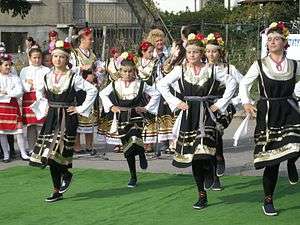
| Part of a series on the |
| Culture of Bulgaria |
|---|
 |
| History |
| People |
| Languages |
|
Mythology and folklore |
| Cuisine |
| Festivals |
| Religion |
| Literature |
|
Music and performing arts |
| Sport |
|
Monuments |
|

A number of ancient civilizations, including the Thracians, Ancient Greeks, Romans, Ostrogoths, Slavs, Varangians and probably Bulgars, have left their mark on the culture, history and heritage of Bulgaria. Because of this Bulgarian nation has one of the richest folk heritage in the world. Thracian artifacts include numerous tombs and golden treasures, while ancient Bulgars have left traces of their heritage in music and early architecture. Thracian rituals such as the Zarezan, Kukeri and Martenitza are to this day kept alive in the modern Bulgarian culture.
The oldest treasure of worked gold in the world, dating back to the 5th millennium BC, comes from the site of the Varna Necropolis.[1]
Bulgaria functioned as the hub of Slavic Europe during much of the Middle Ages, exerting considerable literary and cultural influence over the Eastern Orthodox Slavic world by means of the Preslav and Ohrid Literary Schools. Bulgaria also gave the world the Cyrillic script, the second most widely used alphabet in the world, which originated in these two schools in the tenth century AD.
Bulgaria's contribution to humanity continued throughout the nineteenth and twentieth centuries, with individuals such as John Atanasoff — a United States citizen of Bulgarian and British descent, regarded as the co-father of the digital computer. A number of noted opera-singers (Nicolai Ghiaurov, Boris Christoff, Raina Kabaivanska, Ghena Dimitrova, Anna Tomowa-Sintow, Vesselina Kasarova), pianist Alexis Weissenberg, and successful artists (Christo, Pascin, Vladimir Dimitrov) popularized the culture of Bulgaria abroad.
Music

Bulgaria has a long-standing musical tradition which music historians can trace back to the early Middle ages. One of the earliest known composers of Medieval Europe, Yoan Kukuzel (ca. 1280-1360), became famous for his work Polieleion of the Bulgarian Woman. About 90 of his works have survived. Kukuzel also reformed the Byzantine musical writing system, and became known as The Angel-voiced for his singing abilities.
The tradition of church singing in Bulgaria is more than thousand years old. In the Bulgarian Orthodox Church there are two traditions of church singing - Eastern monodic (one-voice) singing and choral (polyphonic). The Eastern monodic singing observes the tradition of Greek and Byzantine music as well as the requirements of the eight-voices polyphonic canon of the Eastern Orthodox Church. The second tradition is the choral church music, established during the nineteenth century, when in Bulgaria enters the influence of Russian polyphonic choral church music. Many Bulgarian composers (Dobri Hristov, Petar Dinev, etc.) create their works in the spirit of Russian polyphony. Today Orthodox music is alive and is performed both during church worship services and at concerts by secular choirs and soloists. Contemporary Bulgarian worldwide recognized choirs and singers in whose repertoire permanently takes place the orthodox music are: Yoan Kukuzel Choir, Sofia Boys' Choir, Madrigal Sofia Choir, Sofia Orthodox Choir, Sofia Priest Choir, etc., worldwide famous opera singers Boris Christov and Nicola Ghiuselev.
The distinctive sound of Bulgarian folk music comes partly from the asymmetric rhythms, harmony and polyphony, such as the use of close intervals like the major second and the singing of a drone accompaniment underneath the melody, especially common in songs from the Shopi region in Western Bulgaria and the Pirin region.
Bulgarian folk music is unique in its complex harmonies and highly irregular rhythms. These kinds of rhythms, also called uneven beats or asymmetric measures, were introduced to musicologists only in 1886 when music teacher Anastas Stoyan published Bulgarian folk melodies for the first time. Examples of such beats are 5/8, 7/8, 8/8, 9/8 and 11/8, or composite ones like (5+7)/8, (15+14)/8 and (9+5)/16 - (9+5)/16. Each area of Bulgaria has a characteristic music and dance style. Bulgarian folk music inspired and was used by musicians like Kate Bush and George Harrison.
Bulgarian vocal style has a unique throat quality, while the singers themselves are renowned for their range. Their voices are low and soprano and the children love singing as well as anything artistic. Diatonic scales predominate but in the Rhodope mountains, for example, pentatonic scales occur, while in Thrace chromatic scales with augmented intervals (similar to the music of Classical Greece). Also, the intonation varies, and is quite different from the modern Western equal temperament. Depending on whether the melody moves up or down, an interval can augment or decrease by a quarter tone.
Musical instruments (also characteristic of the whole Balkan region) include gaida гайда (bagpipe), kaval кавал (rim-blown flute), zurna or zurla зурна (another woodwind, similar to oboe typical among gipsi), tambura тамбура (guitar-like), gadulka гъдулка (violin-like), and tapan тъпан (large two-sided drum).
The Gaida of Bulgaria is worthy of its own subsection. In Bulgaria the gaida has been a long symbol of the country and its heritage, and is one of the more well known instruments of the country. There is in the Rhodope mountains the deep sounding kaba gaida. In the north, common of dobrudgea and the vlachs there is the dzhura gaida. Also in the stranzha region there is the stranzha gaida. The bag itself is made of goat skin as is traditional, and most often the rims of the different parts of the instrument have a piece of horn on it.
Dances have complex steps matching the rhythm, and are often fast. Most are circle-dances or line dances called horo; but some are done singly or in pairs.
Although traditional music and dance are not popular among Bulgarian city youth, they are often performed at weddings, and generally countryside fiests. They are also performed in Bulgaria and abroad by amateur and professional performing artists and choirs.
Regional folk musical styles abound in Bulgaria. Dobrudzha, Sofia, Rodopi, Macedonia, Thrace and the Danube plain all have distinctive sounds. Traditional folk music revolved around holidays like Christmas, New Year's Day, midsummer, and the Feast of St. Lazarus, as well as the Strandzha region's unusual Nestinarstvo rites on May 21.
Several world-renowned troupes perform Bulgarian folk music, such as the State Ensemble for Folk Songs and Dances, led by Philip Koutev (1903-1982), Trio Bulgarka and the Bulgarian State Television Female Vocal Choir, who featured, among others, on the anthologies titled Le Mystère des Voix Bulgares, volume 2 of which received a Grammy Award in 1989.[2]
One of the best internationally known artists, Valya Balkanska sang the song Izlel e Delyu Haydutin, part of the Voyager Golden Record selection of music included in the two Voyager spacecraft launched in 1977. The Bulgarian State Television Female Vocal Choir also known as Mystery of Bulgarian voices has also attained a considerable degree of fame.
Customs and rites
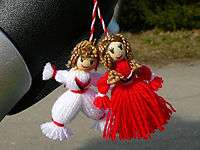
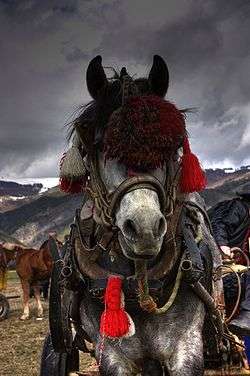
Bulgarians may wear the martenitsa (мартеница) — an adornment made of white and red yarn and worn on the wrist or pinned on the clothes — from March 1 until the end of the month. Alternatively, one can take off the martenitsa earlier if one sees a stork (considered a harbinger of spring). One can then tie the martenitsa to the blossoming branch of a tree. Family-members and friends in Bulgaria customarily exchange martenitsas, which they regard as symbols of health and longevity. The white thread represents peace and tranquility, while the red one stands for the cycles of life. Bulgarians may also refer to the holiday of 1 March as Baba Marta (Баба Марта), meaning Grandmother March. It preserves an ancient pagan tradition. Many legends exist regarding the birth of this custom, some of them dating back to the 7th-century times of Khan Kubrat, the ruler of Old Great Bulgaria. Other tales relate the martenitsa to Thracian and Zoroastrian beliefs.
The ancient Bulgarian ritual of kukeri (кукери), performed by costumed men, seeks to scare away evil spirits and bring good harvest and health to the community. The costumes, made of animal furs and fleeces, cover the whole of the body. A mask, adorned with horns and decoration, covers the head of each kuker, who also must have bells attached to his waist. The ritual consists of dancing, jumping and shouting in an attempt to banish all evil from the village. Some of the performers impersonate royalty, field-workers and craftsmen. The adornments on the costumes vary from one region to another.
Another characteristic custom called nestinarstvo (нестинарство), or firedancing, characterises the Strandzha region. This ancient custom involves dancing into fire or over live embers. Women dance into the fire with their bare feet without suffering any injury or pain.
UNESCO World Heritage Sites
Bulgaria has nine UNESCO World Heritage Sites:
- The early medieval large rock relief Madara Rider
- Two Thracian tombs (one in Sveshtari and one in Kazanlak)
- Three monuments of medieval Bulgarian culture (the Boyana Church, the Rila Monastery and the Rock-hewn Churches of Ivanovo)
- Two examples of natural beauty: the Fisherman Momerioland the Sreburna Nature Reserve
- The ancient city of Nessebur — a unique combination of European cultural interaction, as well as, historically, one of the most important centres of seaborne trade in the Black Sea
Local archaeologists assume that the number of archaeological sites is the third-largest in Europe after Italy and Greece.[3]
Theatres
According to the Bulgarian Statistical Institute as of 2005 there were 75 theatres in Bulgaria (including Opera and Ballet houses) with around 30,000 seats altogether. [4]
Visual art

Bulgaria has a rich heritage in the visual arts, especially in frescoes, murals and icons. The Thracian Tomb of Kazanlak offers fine examples of excellently preserved ancient Thracian art. Tomb art provides one of the most important sources of information about Thracian lifestyle and culture. Visual arts in the Bulgarian lands experienced an upsurge during the entire period of the Middle ages. The crypt of the Alexander Nevski cathedral features an exhibition of a large collection of medieval icons. The earliest of those dates from around the 9th century AD. The Tarnovo Artistic School, the mainstream of the Bulgarian fine arts and architecture between 13th and 14th centuries, takes its name from the capital and main cultural center of the Second Bulgarian Empire, Tarnovo. Although it shows the influence of some tendencies of the Palaeologan Renaissance in the Byzantine Empire, the Tarnovo painting had its own unique features which makes it a separate artistic school.[5] Art historians classify its products into two types:
- mural painting: mural decoration of churches
- iconography: easel painting
The works of the school show some degree of realism, portrait individualism and psychology.[6]
The unique and realistic portraits in the Boyana Church class as forerunners of the Renaissance.[7]
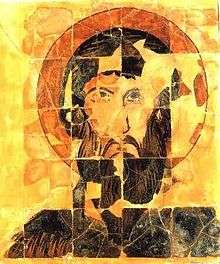
The wall piers and the arches often featured medallion-shaped bust images of saints. Magnificent examples of those survive in SS Peter and Paul Church in Tarnovo. Along with traditional scenes such as "Christ's passions" and "Feast cycle" in the second layer; "Christ Pantokrator" in the dome and the Madonna with the infant Christ in the apse, specific images and scenes also appear. During the period of Ottoman rule (1396-1878) the authorities suppressed Bulgarian art. Many churches suffered destruction, and newly built ones remained somewhat modest. In the end of the 18th century the Islamic Ottoman Empire began to decay slowly, thus permitting the Bulgarian National Revival of the 18th and 19th centuries to occur. Bulgaria experienced a revival in every area of culture. Following the Liberation in 1878, fine arts rapidly recovered and came under the influence of European artistic currents such as late Romanticism.
Cuisine

Due to the relatively warm climate and diverse geography affording excellent growth-conditions for a variety of vegetables, herbs and fruits, Bulgarian cuisine (Bulgarian: българска кухня, bulgarska kuhnya) offers great diversity.
Famous for its rich salads required at every meal, Bulgarian cuisine also features diverse quality dairy products and a variety of wines and local alcoholic drinks such as rakia (ракия), mastika (мастика) and menta (мента). Bulgarian cuisine also features a variety of hot and cold soups, for example tarator. Many different Bulgarian pastries exist as well, such as banitsa, a traditional pastry prepared by layering a mixture of whisked eggs and pieces of sirene between filo pastry and then baking it in an oven.
Traditionally, Bulgarian cooks put lucky charms into their pastry on certain occasions, particularly on Christmas Eve, the first day of Christmas, or New Year's Eve. Such charms may include coins or small symbolic objects (such as a small piece of a dogwood branch with a bud, symbolizing health or longevity). More recently, people have started writing happy wishes on small pieces of paper and wrapping them in tin foil. Wishes may include happiness, health, or success throughout the new year.
Bulgarians eat banitsa — hot or cold — for breakfast with plain yogurt, ayran, or boza. Some varieties include banitsa with spinach (спаначена баница / spanachena banitsa) or the sweet version, banitsa with milk (млечна баница / mlechna banitsa) or pumpkin (тиквеник / tikvenik).
The Bulgarian lyutenitsa (лютеница) comprises a spicy mixture of mashed and cooked tomatoes, aubergines, garlic, hot peppers and vegetable oil, seasoned with salt, pepper and parsley. Variations of lyutenitsa exist in the national cuisines of most Balkan states.
Tripe soup (шкембе чорба / skhembe chorba) takes as its basis the thick lining of the cleaned stomach of cattle, prepared with milk and seasoned with vinegar, garlic and hot peppers. Under Ottoman rule, the sultans allegedly preferred tripe soup made by Bulgarian cooks, whose mastery in preparing the dish remained unmatched in the Balkans.
Exports of Bulgarian wine go worldwide, and until 1990 the country exported the world's second-largest total of bottled wine. The rich soil, perfect climate and the millennia old tradition of wine-making, which dates back to the time of the Thracians, contributes to the wide variety of fine Bulgarian wines. As of 2007, Bulgaria produced 200,000 tonnes of wine annually,[8] ranking 20th in the world.[9]
Media
Bulgaria's media are generally deemed unbiased, although the state still dominates the field through the Bulgarian National Television (BNT), the Bulgarian National Radio (BNR), and the Bulgarian Telegraph Agency. Bulgarian media have a record of unbiased reporting, although they are deemed potentially at risk of political influence due to the lack of legislation to protect them.[10] The written media have no legal restrictions and newspaper publishing is entirely liberal.[11] The extensive freedom of the press means that no exact number of publications can be established, although some research put an estimate of around 900 print media outlets for 2006.[11] The largest-circulation daily newspapers include Dneven Trud and 24 Chasa.[11]
Non-printed media sources, such as television and radio, are overseen by the Council for Electronic Media (CEM), an independent body with the authority to issue broadcasting licenses. Apart from a state-operated national television channel, radio station and the Bulgarian News Agency, a large number of private television and radio stations exist. However, most Bulgarian media experience a number of negative trends, such as general degradation of media products, self-censorship and economic or political pressure.[12] Slavi's Show and Gospodari Na Efira are among the most popular TV programs, both having more than 1,000,000 views per show.[13]
Internet media are growing in popularity due to the wide range of available opinions and viewpoints, lack of censorship and diverse content.[12]
Religion
Bulgaria is officially a secular nation and the Constitution guarantees the free exercise of religion but designates Orthodoxy as a "traditional" religion. In the 2001 census, 82.6% Bulgarians declared themselves Orthodox Christians, 12.2% Muslim, 1.2% other Christian denominations, 4% other religions (Buddhism, Taoism, Hinduism, Judaism) and zero percent atheists. Most citizens of Bulgaria have associations — at least nominally — with the Bulgarian Orthodox Church. Founded in 870 AD under the Patriarchate of Constantinople (from which it obtained its first primate, its clergy and theological texts), the Bulgarian Orthodox Church had autocephalous status since 927 AD. The Church became subordinate within the Patriarchate of Constantinople, twice during the periods of Byzantine (1018 – 1185) and Ottoman (1396 – 1878) domination. It was re-established first in 1870 in the form of the Bulgarian Exarchate, and then in the 1950s as the Bulgarian Patriarchate.
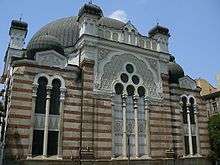
Islam came to Bulgaria at the end of the fourteenth century after the conquest of the country by the Ottomans. It gradually gained ground throughout the fifteenth and sixteenth centuries through the introduction of Turkish colonists. One Islamic sect, Ahmadiyya, faces problems in Bulgaria. Some officials have moved against Ahmadis[14] on the grounds[14] that other countries also attack the religious rights of Ahmadis, who many[14] Muslims regard as heretical.
In the sixteenth and the seventeenth centuries, missionaries from Rome converted Bulgarian Paulicians in the districts of Plovdiv and Svishtov to Roman Catholicism. Today their descendants form the bulk of Bulgarian Catholics, whose number stood at 44,000 in 2001. Missionaries from the United States introduced Protestantism into Bulgarian territory in 1857. Missionary work continued throughout the second half of the nineteenth and the first half of the twentieth century. In 2001 Bulgaria had some 42,000 Protestants.
Buddhism, Hinduism and Taoism became popular among Bulgarians in the time of perestroika and especially after the fall of communist regime[15] and are usually a co-religion or co-belief to Bulgarians who otherwise are Christians (Roman Catholicism or Orthodoxy). Among these Eastern (Asian) religions Buddhist centres are officially registered in Bulgaria as religious denominations. The number of followers of Buddhism has increased gradually in recent years also due to the influx of Vietnamese citizens (predominantly Buddhist) to Bulgaria.[16]
According to the most recent Eurostat "Eurobarometer" poll, in 2005,[17] 40% of Bulgarian citizens responded that "they believe there is a God", whereas 40% answered that "they believe there is some sort of spirit or life force", 13% that "they do not believe there is a God, spirit, nor life force", and 6% did not answer.
See also
References
- ↑ New perspectives on the Varna cemetery (Bulgaria), By: Higham, Tom; Chapman, John; Slavchev, Vladimir; Gaydarska, Bisserka; Honch, Noah; Yordanov, Yordan; Dimitrova, Branimira; September 1, 2007
- ↑ "Past Winners". Grammy.com. National Academy of Recording Arts and Sciences. Archived from the original on 28 July 2014.
- ↑ "Bulgaria's Treasure Hunters and the Lost Rome". Novinite. 2 June 2011. Retrieved 20 December 2011.
- ↑ "Bulgarian Statistical Institute - Theatres in 2005". www.nsi.bg. Archived from the original on 2007-11-17. Retrieved 2008-04-18.
- ↑ Graba, A. La peinture religiouse en Bulgarie, Paris, 1928, p. 95
- ↑ Цончева, М. За Търновската живописна школа. - В: Търновска книжовна школа. 1371-1971, С., 1974, с. 343.
- ↑ "Старобългарско изкуство", Том ІІ - Никола Мавродинов, издателство "Наука и изкуство", София, 1959 г.
- ↑ "Руснаците купиха 81 милиона литра българско вино". Investor.bg. Retrieved 2011-02-10.
- ↑ See List of wine-producing countries
- ↑ Library of Congress – Federal Research Division (October 2006). "Country Profile: Bulgaria" (PDF). Library of Congress. pp. 18, 23. Retrieved 4 September 2009.
Mass Media: In 2006 Bulgaria’s print and broadcast media generally were considered unbiased, although the government dominated broadcasting through the state-owned Bulgarian National Television (BNT) and Bulgarian National Radio (BNR) and print news dissemination through the largest press agency, the Bulgarian Telegraph Agency. [...]Human Rights: In the early 2000s, Bulgaria generally has been rated highly on the issue of human rights. However, some exceptions exist. Although the media have a record of unbiased reporting, Bulgaria’s lack of specific legislation protecting the media from state interference is a theoretical weakness.
- 1 2 3 Media Landscape – Bulgaria Archived July 22, 2010, at the Wayback Machine., European Journalism Centre
- 1 2 Footprint of Financial Crisis in the Media, Bulgaria Country Report, Open Society Institute, December 2009
- ↑ 20-те най-гледани предавания са по bTV, без изключение!, slusham.com, January 2010
- 1 2 3 Corley, Felix. "Ahmadis barred "because it is against the religions that people follow here"". Forum 18. Oslo: Forum 18 News Service. pp. 1–3. Retrieved 2008-09-01.
Bulgaria's small Ahmadi Muslim community is concerned by persistent attempts by a local prosecutor and the national state Religious Affairs Directorate to strip it of its legal status
- ↑ "Историята на центъра ни | Тибетски будизъм - Будистки център Шечен България". Shechen-bg.org. Retrieved 2011-02-10.
- ↑ Виетнамците се завръщат у нас, BGBen.co.uk
- ↑ "Social values, science and technology" (PDF). Eurobarometer. European Commission. June 2005. Archived from the original (PDF) on 2006-05-24. Retrieved 2007-01-01.
Sources
- Klingemann, Hans-Dieter (2006). Democracy and Political Culture in Eastern Europe. Routledge. pp. 336–353. ISBN 0-415-38602-0.
External links
- Center for Traditional Music and Dance
- Nikolov, A. The Perception of the Bulgarian Past in the Court of Preslav around 900 AD. - In: State and Church: Studies in Medieval Bulgaria and Byzantium. Ed. by V. Gjuzelev and K. Petkov. American Research Center in Sofia: Sofia, 2011, 157-171
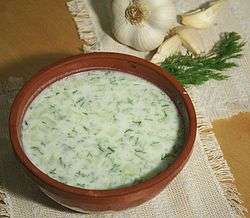
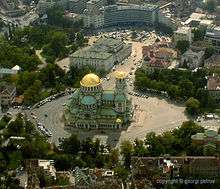
.svg.png)